At the end of April, astronomers in the Northern Hemisphere expected the appearance of comet C/2021 O3 (PanSTARRS) in the evening sky, which was supposed to move from behind the Sun and even become visible to the naked eye. Numerous observers pointed their telescopes at the place where the “tailed star” was supposed to be… but only the pictures of in the twilight sky shot by the 4-meter reflector of the Lovell Observatory, allowed to discern a faint nebula of the 9th magnitude — 5 magnitudes (a hundred times!) weaker than expected.
Meanwhile, the much fainter short-period Comet 45P/Honda-Mrkos-Pajdušáková, known for passing close to Earth on its two previous returns in 2011 and 2017, also appeared from beyond the Sun. This time it was separated from us by quite a distance of about 1.5 AU, and astronomers rightly believed that it would remain a faint object accessible only to powerful instruments. However, in mid-May, several observers immediately noted a sharp increase in its brightness to almost the 7th magnitude instead of the predicted 10th, that is, about 15 times more.
The hard temper of “tailed stars”
So far, astronomers can only guess about the causes of comet flares and extinctions. Spacecraft have already approached eight comets and transmitted images of the nuclei of six of them. But only one of those devices — the Rosetta probe sent to 67P/Churyumov-Gerasimenko comet — had stayed by the comet long enough to record some non-stationary processes in the cometary nucleus. Unfortunately, during the entire time of its operation, no significant “flash” events occurred with this comet.
The first mentions of comet flares were made in the second half of the 18th century, when astronomers began regular observations of these objects. Comet 17P/Holmes was discovered in November 1892, and, as is known today, this happened during one of its famous “explosions” — it is difficult to give any other name to the events when the brightness of a celestial body increases by almost 10 star magnitudes in a few hours, i.e. several thousand times. On October 24, 2007, its apparent brightness suddenly rose from 14.5m to 2.8m (that is, its radiation increased 48 thousand times), and the comet became visible to the naked eye as an extra “star” in the Perseus constellation. Later, the gas cloud ejected by the flare expanded and turned into a wonderful glowing “jellyfish”.
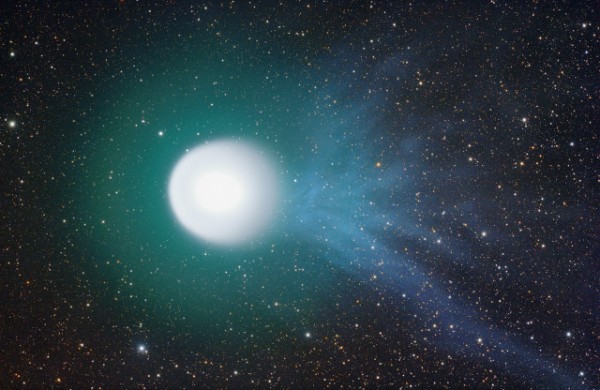
The “explosions” of Comet Holmes are irregular and unpredictable, as are the smaller-scale flares of other comets, which occur even less frequently. Only in recent decades, scientists have acquired powerful enough means of observation and statistical material to allow them making assumptions about the possible causes of such phenomena.
Causes of cometary “fireworks”
Comets spend most of their time in the parts of their orbits far from the Sun. The main events in their lives begin in the process of approaching the luminary and passing perihelion. Comet nuclei heat up, and the volatile substances in their composition begin to intensively evaporate. Here the first surprises await us, since these substances have very different boiling points: water ice in a vacuum begins to evaporate (sublimate) at 0°C; ammonia and carbon dioxide don’t need such a strong “heating”, while methane, carbon monoxide gas and hydrogen sulfide generally turn into gas under conditions of deep cold. If an ice block contains an inclusion, such as methane, it can vaporize and rupture the surrounding ice, causing a rapid, massive release of the gas.
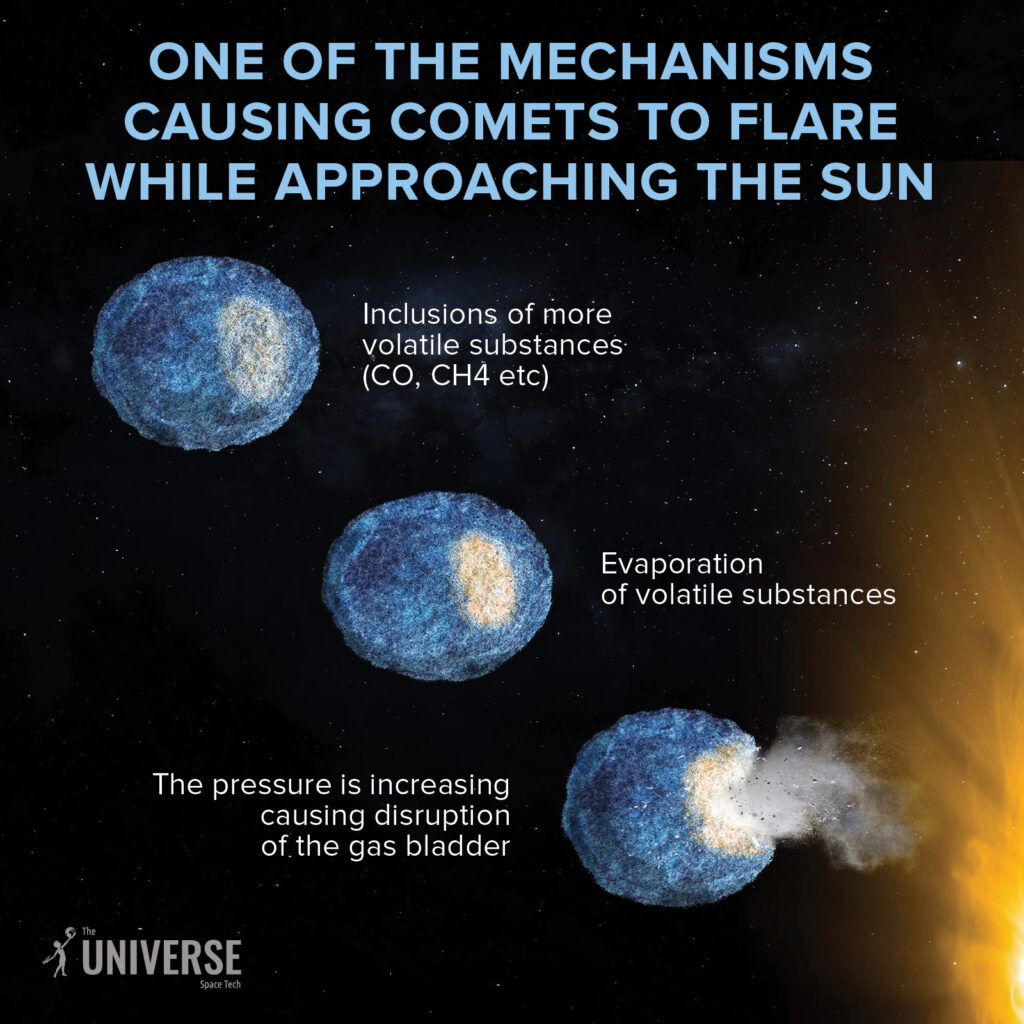
We should also remember that, in addition to volatile substances, comet nuclei also contain dust — small particles of minerals and high-boiling organic compounds. Since the masses of comets are usually small, their gravity does not prevent this dust from flying off into space together with the fumes. If the orbit of the “tailed star” lies close to the Earth’s, the ejected dust can enter the atmosphere of our planet, forming a meteor shower. But if there is too much dust in the comet, it begins to behave differently.
In the vacuum of space, even with a slight heating, the dust easily sticks together, forming a rather dense crust on top of individual areas or the entire cometary nucleus. On the one hand, this crust is almost black, thanks to which it intensively absorbs sunlight and heats up even more. On the other hand, its thermal conductivity is quite low. However, the underlying volatile substances still gradually evaporate, and at some point the formed gases “breaks through” the crust. The resulting gas jets were repeatedly recorded by the Rosetta device. Scientists suggest that larger-scale events of this type could result in a dramatic increase in the comet’s overall brightness.
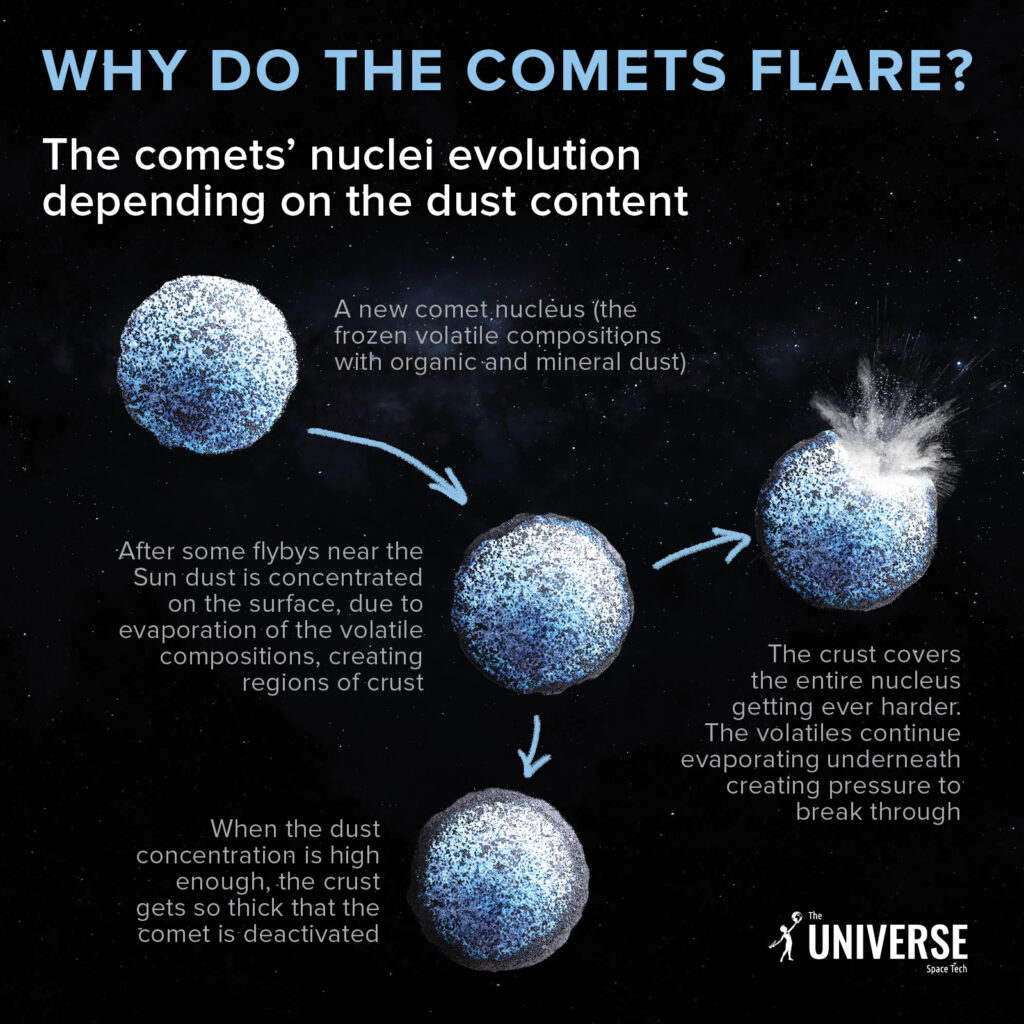
A collision of a cometary nucleus with a small “heavenly stone” can have a similar result. This option has already been tested experimentally. On July 4 2005, the American Deep Impact spacecraft dropped a 370-kilogram copper projectile onto 9P/Tempel comet, which crashed into it at a speed of 10.3 km/s. A few hours after the impact, ground-based observers recorded an increase in the total brightness of the comet by one and a half magnitudes, that is, approximately four times.
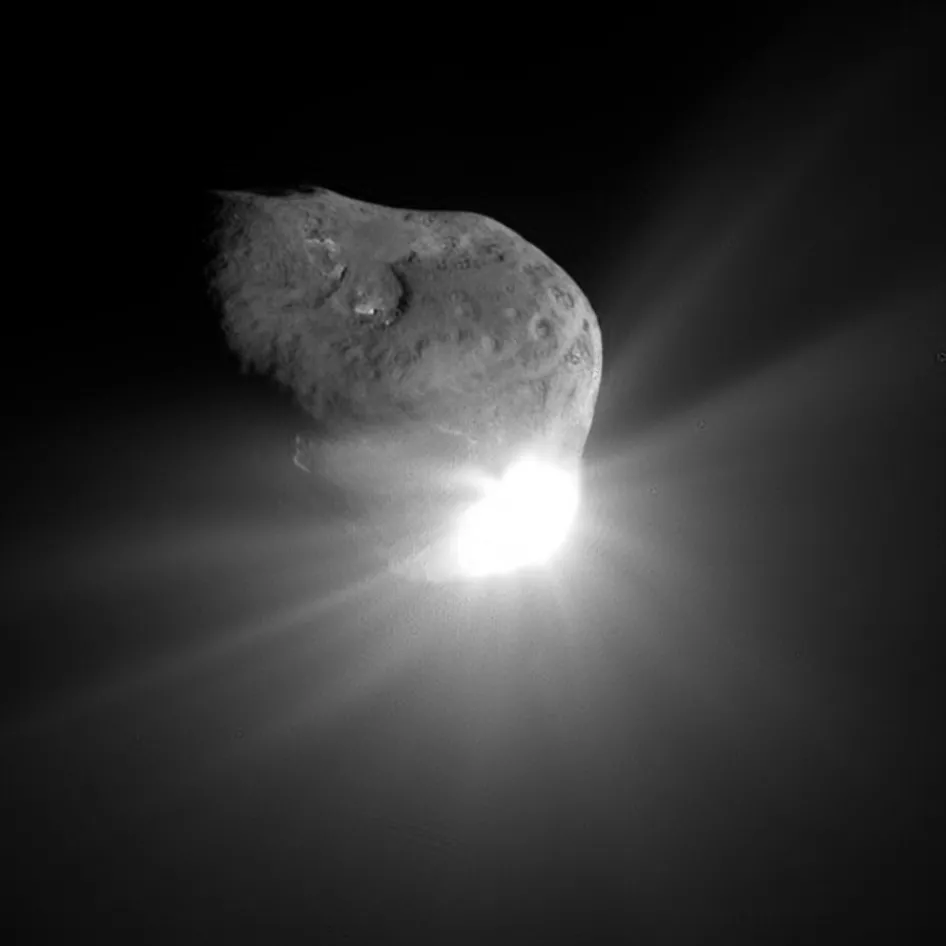
However, planetologists also name more exotic causes for comet flares. Some of them occur far from the Sun, where there is too little energy to “feed” such large-scale events. Therefore, all the necessary energy must be contained in the cometary nucleus. It is believed that water ice is present in it in an amorphous form, and sometimes, for reasons that are not entirely clear, it can begin to turn into a crystalline modification — the one we are used to in terrestrial conditions. The energy of this process is high enough to explain some “cometary fireworks”. But not all of them.
There is also an assumption that cometary nuclei contain ordinary explosive substances. They are formed there over billions of years of exposure to cosmic rays and high-energy radiation that split water molecules into atoms. The formed hydrogen, as a lighter and more volatile element, quickly “slips away” into the surrounding space, and oxygen, far from the Sun, remains frozen. However, comets also contain organic compounds, the main component of which is carbon. Mixtures of such organic matter with liquid oxygen are technically known as oxyliquits and can be used as the simplest explosives.
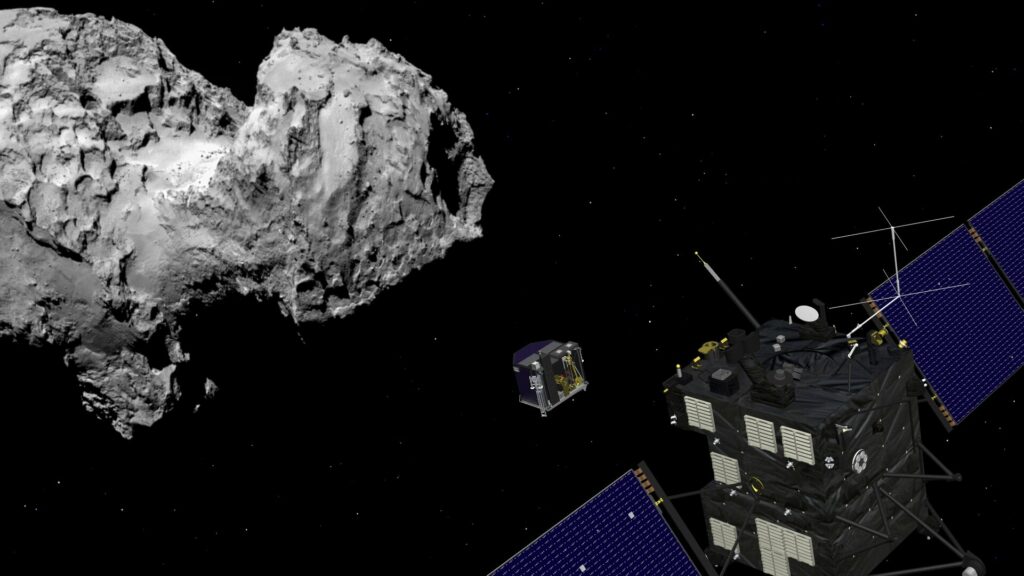
The Phiilae lander dropped by the Rosetta probe on the nucleus of the Churyumov-Gerasimenko comet could confirm or refute this hypothesis. Unfortunately, it landed away from the targeted location and was unable to effectively carry out its scientific program.
When comets go out
The most common cause of a comet’s extinction is the complete disintegration of its nucleus. This has already been observed many times, historically the first example was the bright comet 3D/Biela, which began to disintegrate in 1846, and by 1866 this process was largely completed, and only the Andromeda meteor shower remained as a reminder of the “tailed star”. Very often, comets disintegrate during close approaches to the Sun: its powerful radiation causes intense heating and almost explosive evaporation of volatile substances.
The decay of the nucleus of comet Schwassmann-Wachmann-3 in April 2006. The video is based on images taken by the Hubble telescope
However, another option is also possible, when the nucleus remains intact, but its volatile matter is exhausted over time, and it loses the ability to form a coma and a tail — the main components of a comet. Unlike decay, which is an irreversible process, further “revival” is still possible in this case. For example, if there are inclusions of water, carbon dioxide or methane ice somewhere deep in the dust layers, they may at some point heat up and begin to evaporate. They can also be “pulled to the surface” by the collision of the nucleus with a meteorite. In most cases, this will be observed from Earth as a flash.
If the concentration of non-volatile compounds in the comet nucleus is high, its “sealing” with dust can happen even during the first “flight” to the Sun. Something like that happened, for example, with Comet Austin in the spring of 1990. Instead of reaching the predicted zero magnitude and becoming a bright object in the evening sky, it barely reached 4th magnitude and was observed with great difficulty. The spectra of this celestial body indicated the strong dustiness of the coma. Probably, the main part of the dust remaining on the surface of the core, formed a heat-insulating crust and significantly weakened the evaporation of volatile substances.
Further research
“Extinct” comets moving in short-period orbits are excellent targets for spacecraft. In 2024, the Japanese space exploration agency JAXA is going to perform the DESTINY mission to the asteroid 3200 Phaethon — the parent body of the powerful Geminid meteor shower — to test its cometary nature. This will be a flyby mission that does not involve sending a lander to the asteroid.
An even more interesting object is the unusual comet 29P/Schwassmann-Wachmann. Its orbit is close to circular and lies completely outside the orbit of Jupiter — in a region of space where most of the “tailed stars” do not show significant activity. But this comet manages to flare up on average more than 7 times a year, and the growth of its brightness can reach 5 magnitudes. The reason for such “restless” behavior still remains a mystery to astronomers. The core of 29P/Schwassmann-Wachmann is known to be about 60 km in size, and it rotates on its axis extremely slowly, making one revolution in 57 days. During the flares, significant amounts of dust are ejected from the core.
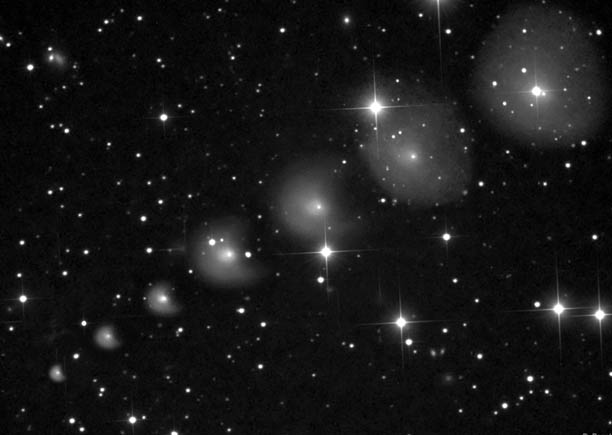
The first offers to send a mission to Schwassmann-Wachmann-1 appeared as early as 1987. Finally, in 2019, NASA started working on the Chimera project with a launch date for 2025-2026, which involves the launch of a probe into orbit around this comet. Unfortunately, the project has slowed down a lot due to the COVID-19 pandemic and has very little chance of implementation as for now. However, the scientific community continues to promote it, emphasizing the potential value of the information obtained for further studies of small bodies in the Solar System.
Of course, amateur observations play a significant role in such studies. Often, lay astronomers are the first to notice comet flares and report on these events, drawing public attention to them. And nowadays, when amateurs have access to sensitive CCD arrays and quite powerful telescopes in remote access mode, the value of the data they receive increases many times over. Sometimes they qualitatively complement the information transmitted by spacecraft — as it was during the Deep Impact mission, for example. Moreover, this is not the only example of such cooperation and, obviously, not the last one.

